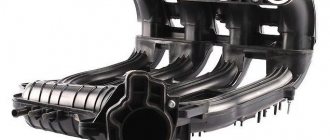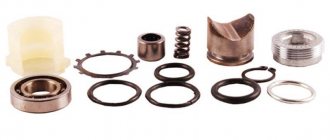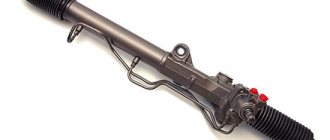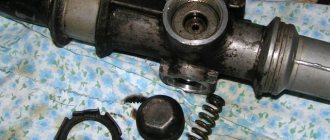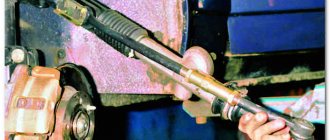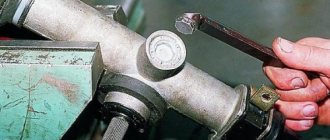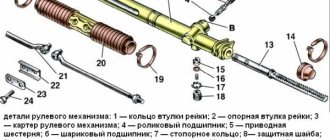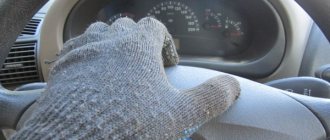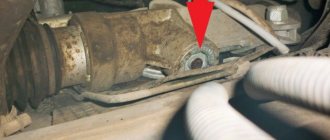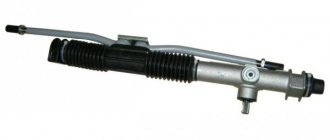Installation of steering rack Lada Priora
Before installation, check that the rail is installed in the middle position. To do this, using sliding pliers, use the flat on the gear shaft to rotate the shaft in any direction until it stops, then turn the shaft in the opposite direction two full turns and turn the shaft so that the flat on the shaft is located vertically on the right side along the direction of the car. Otherwise, the installation of the rack is carried out in the reverse order. The steering rack of the Lada Priora is the same as the rack of the Kalina or VAZ 2110-2112 of the new model and has a catalog number: 11183-3400010 (rasp inside 21100-3401068). Price approximately 3500 rub.
The Priora steering rack with power steering is no different from the usual one, but the Priora steering rack with power steering has a different catalog number (see interchangeability of VAZ steering racks).
What is the steering rack for front wheel drive cars?
In cars with front-wheel drive, there is no way to install the classic, long-proven front wheel steering control system. The transverse installation of the motor and power drives to the wheels will not allow this to be done. Therefore, the cumbersome system of levers was replaced by a steering rack. Its main task is to transfer force from the steering wheel to the steering arms.
Important! Most Priors are equipped with electric power steering (EPS) and not power steering. This is a feature of this model.
Location and design of the Priora steering rack with EUR
To save space, this element of the Priora control system is located on the wall of the engine compartment. On the bulkhead between the engine and the interior of the Priora. The rack is connected to the steering column located in the cabin.
Steering rack device
This important Priora control unit is assembled from the following components.
- The rack is mobile.
- Frame.
- Splined shaft with bearing.
- Metal case (casing).
- Seals and seals.
- Fasteners and accessories (bolts, nuts).
- Springs.
- Rubber cover for the mechanism.
The basis of this mechanism is a metal pin (rail), so to speak. There are teeth on one part of it. They are mated to the steering wheel drive shaft, located at right angles to the supporting pin. This is, in fact, the well-known worm gear. The rotating shaft moves, engaging the teeth, the rack inside the casing. The protective casing has a special slot for attaching tie rod ends. In the center of the pin (rack) there are special holes for tips, which are connected through special levers to turning wheels.
Malfunctions and their symptoms in the Priora steering rack with ESD
Most often, the rubbing parts of this unit fail. It is quite easy to determine whether the steering mechanism is broken or simply worn out. This will be marked by the following signs:
- The steering wheel is difficult to turn.
- When entering a turn, tapping and grinding noises are heard from the mechanism.
- While driving, when using the steering wheel, sensitive shocks are transmitted from it to the hands.
In general, the handling of the Priora is significantly deteriorating.
During the inspection, the technician will determine the need to replace the Priora steering rack by visual inspection. Usually, he grabs the rod with his hand, and his partner turns the steering wheel. Based on excessive play and extraneous sounds, the technician makes a verdict.
Attention! This device is completely repairable. Ready-made repair kits for the Priora steering rack are available for sale. There are separate articles on this topic.
Airbag installation
Installation is carried out in reverse order. While working, stay outside the pillow deployment area. When you first turn on the ignition, stand outside the vehicle and turn on the ignition with your hand under the steering column.
Have you experienced a knocking sound in your steering? Let's solve this problem together.
Good day! Status: Verified
Story
: (Can be skipped). The steering rack was repaired, with removal and partial disassembly (without removing the steering tips, or as they are called “steering rods”). So, after installing the rack back, in order to get the bolt into the slots of the steering wheel with the rack, I had to turn the latter by 30 degrees, which ultimately resulted in an uneven position of the steering wheel.
In fact:
The steering wheel is not level relative to the level position of the wheels. Correction options:1.
Rearranging the steering rack by pulling out the steering wheel mounting with the steering rack from the splines. (I advise you to do this only if you need to re-assemble the rail). Time costs: 2 days .2.
Perform wheel alignment and tell people to set the steering wheel straight. Cost: 1 hour.
1000 rubles 3. Turn the steering wheel 30 degrees.
Costs: 1 hour, +1 neighbor.
I made decision No. 3 and after that go to the alignment. Does anyone think he did the right thing? I’ll add that the car was re-shoeed with summer wheels that were balanced.
Tools:
socket wrench (head) “24”, screwdriver with a flat blade, hex key “5”. Work:
Using the instructions “Removing and installing the steering wheel of Lada Priora, VAZ 2170, VAZ 2171, VAZ 2172” we do this:
1. Take a screwdriver with a 5 mm hex head. We insert it into the hole in the airbag mounting in the steering wheel. Unscrew the 2 bolts (They cannot be removed from the passes).
2. As soon as the bolts are unscrewed, the cushion will move slightly relative to the steering wheel.
3. Carefully turn the pillow sideways. Inspect the connector fastening.
4. Pry up the green clamp of the control wire block (which is in the center).5. Now we pull out the entire connector from the mounting groove.6. The pillow is removed and put aside.
Signs of play in slats
When driving over small irregularities such as a gravel road, shocks and knocks in the suspension are clearly audible and are transmitted to the steering wheel. These signs will not always refer to play in the rack. Similar impacts to the steering wheel can occur due to broken steering ends or a broken crosspiece of the steering mechanism. Before you begin repairing the rack, you must exclude the tips and steering cross from suspicion.
- Impacts to the steering wheel when driving over bumps
- Creaking sound when turning the steering wheel
- Biting the steering wheel in different positions
- The steering wheel does not return to zero position
Checking for play
Checking for play is done by rocking the swing arms up and down. To do this, we find the steering rods under the hood and pull each of them up and down; there should be no play or knocking. If any, then the rack should be maintained.
How to tighten the steering rack on a Priora
Lada Priora is a Russian-made car that is highly popular among our compatriots due to its low price and attractive appearance. However, even despite this, the Lada Priora has one vulnerability associated with the poor quality of the road surface - the steering rack or, in the language of specialists, the “power steering/power steering gearbox”. Fortunately, you can tighten it with your own hands.
When does the steering rack need to be tightened on a Priora?
The steering rack is a vulnerable point for Lada Priora
The first sign indicating the need to adjust the rack is the appearance of a knocking sound when driving over small uneven surfaces. The knocking will be felt especially clearly when driving on country roads. In this case, the driver will feel shocks and vibrations on the steering wheel, which will also be transmitted to the entire car body.
In addition, if the steering wheel adjustment nut is loosened when driving on the highway, the car will “float” a little, and additional steering will be required from the driver, which will also immediately become noticeable.
Experts also say that a tightening is necessary if the driver begins to notice the appearance of a clearly audible crunching sound in the area of the steering column, as well as an increase in the amplitude of the steering wheel rotation.
When tightening doesn’t help and the mechanism needs to be changed
It’s worth thinking about replacing the rack when tightening it does not in any way affect the car’s behavior on the road, and also does not help get rid of the unpleasant knocking noise. A failed steering rack will cause significant play in the steering wheel. Moreover, it may begin to jam (this happens extremely rarely, but similar cases are known). If the rack begins to jam, then it is better to stop using the car, as this can lead to the most dire consequences.
You cannot do without a replacement even if after tightening it you managed to get rid of knocks and vibrations, but they reappeared later.
: Audi intends to develop another SUV
What is needed for work and how to tighten the steering
To tighten the steering rack you will need special wrenches
To perform the tightening you will need the following tools:
- Slotted screwdriver (in simple terms, a “flat” screwdriver);
- Wrench 13;
- A special 17mm wrench designed to adjust the steering rack.
To make the work more comfortable and faster, it is recommended to drive the car into a special inspection hole or overpass, and also use an assistant, whose role even a child can handle.
The lower rack fastening nut is not easy to unscrew
To get to the rail, you should perform a number of simple steps:
- Disconnect the battery terminals and dismantle it;
- Using a 13mm wrench, unscrew the bolt securing the battery stand, and then remove it;
- Directly under the steering rack, using a slotted screwdriver, you need to pull out the small plug of the adjustment system.
After this, you will have access to the nut responsible for adjusting the thermal gap in the rail.
Next, you need to put your hand under the steering rack and try to put the rack wrench on the nut. It is necessary to tighten the nut clockwise, but since the rack itself is located upside down, from the outside it may seem that the nut must be tightened counterclockwise. Experts recommend tightening the nut no more than 25–30 degrees at a time, after which you should try to rotate the steering wheel, which should turn without jerking or biting.
It is also necessary to listen to the sounds coming from the steering wheel - if there are no knocks when turning the steering wheel, and there are no other noises, then the rack is tightened correctly, and you can put the battery and rubber plug in their place.
The nuances of working on a car with EUR and power steering
According to experienced auto mechanics, the process of tightening the steering rack on cars with electric steering and power steering is practically no different, so this guide can be called universal.
: About anti-corrosion treatment of cars
It is worth noting that the complete replacement process is also identical in the case of electric steering and power steering, with the exception of one point - in cars with power steering, before replacing the rack, it is necessary to drain the fluid from the power steering tank, and in cars with electric steering, remove the terminals from the battery.
Electric amplifier breakdowns
To diagnose a malfunction of the electric amplifier, you first need to determine the conditions under which the problem arose. There may be several of them:
- the failure occurred after discharging and then charging the battery;
- after turning the steering wheel at a large angle;
- when performing a parking maneuver;
- when driving at speeds above 110 km/h.
Based on these reasons, we can draw a conclusion about the nature of the occurrence of malfunctions. Often the cause of malfunction is low voltage of the on-board network. For normal operation of the EUR, the voltage must be at least 13.5 V. First, the battery is checked. If it is working, it is possible that the on-board network was de-energized after the battery was removed for recharging. To resume work, sometimes it is enough to turn the steering wheel 5-6 times to the extreme positions and back.
If everything is fine with the battery, you need to check the insulation of the wiring and connections for short circuits. The EUR on the Priora does not work in constant mode, like the power steering. The maximum load on the electric motor occurs when the steering wheel rotates at low speed or the car is stationary; the minimum load occurs when driving at speeds over 100 km/h. After reaching 110 km/h, the electric booster does not work at all.
If you hear knocking or other suspicious sounds while driving when turning the steering wheel, the fastening nut may have become loose - it needs to be lubricated and tightened. To do this, you need to dismantle the apron under the steering wheel and remove the casing. Sometimes a situation may arise when the wheels turn spontaneously. This directly indicates a malfunction of the electric power steering control unit.
The main problem with the EUR Lada Priora is that in order to reduce the cost of the design, a high-quality German-made electrical circuit was replaced with a domestic analogue, modified, but “crude”.
If the amplifier and speedometer do not work, then the problem is in the speed sensor - it is either dirty or faulty. The same goes for torque and steering angle sensors. First you need to clean them and reset errors from the on-board computer; for this you can use several methods:
- remove the terminal from the battery, de-energizing the on-board network;
- using diagnostic programs and an adapter for connecting to the OBD II diagnostic connector.
If you suspect that a fuse has blown, it should be checked and replaced if necessary. It is located in the mounting block, in the cabin, below the steering wheel on the left side. If any of the listed malfunctions occur, you can fix them yourself, but to completely replace the electric power steering mechanism, it is better to contact specialists.
Briefly about the mechanism
The element is a cylindrical body containing the following parts:
- the gear rack itself, moving inside the bushings;
- drive shaft with helical gear, rotating on 2 bearings (connected to the steering column);
- 2 rods connected to the ends of the rack and pinion mechanism and the steering knuckles of the hubs;
- a system of stops and springs that limit the travel of the rack and select the backlash of the gear transmission;
- rubber covers (anthers) in the form of round “accordions” that protect the mechanism crankcase from dirt;
- the element body is filled with liquid lubricant.
This is the design of a conventional mechanical and so-called electric rack, operating in conjunction with an electric power steering (EPS). If the car is equipped with a hydraulic booster (power steering), then the design of the mechanism is supplemented with cylinders and pistons that help move the gear bar in one direction or another.
The element works on a simple principle: when the steering wheel rotates, the drive shaft moves the rack through a gear in the required direction. The ends of the part connected to the rods cause the front wheels to turn. The power steering or electric power steering reacts to the movement of the steering wheel and “pushes” the rack and pinion mechanism in the desired direction, relieving physical stress from the driver.
EUR and power steering Priora: list of possible faults and repair methods
Hydraulic and electric power steering are designed to ease the effort the driver makes when turning the steering wheel. The EUR is a more advanced mechanism compared to the power steering, since it uses an electric drive. The system does not contain oil or other hydraulic components, which increases its reliability. Typically, AvtoVAZ engineers install electric steering systems on passenger cars, and less often - power steering. Both types of power steering are found on the Lada Priora.
Steering diagram
Video
This video shows how to repair the steering mechanism on Kalina.
Knock in Kalina steering rack. How to remove.
Installation of Kalina steering rack.
Repair of the steering column gearbox and the RR itself on Priora, Kalina, Grant.
How to install a steering rack from Kalina 2 to Kalina 1.
Steering rack for Lada Kalina Sport with a gear ratio of 3.1 instead of 4.02.
Do-it-yourself repair of the steering rack, but not Kalina, but Daevoo Sens / Daewoo Sens.
Kalina control rack - VAZ 11183 Kalina rack repair
Have you ever had a chance to monitor knocks and noises from the side? Probably it happened. They changed the control tips, changed the ball tips, even changed the springs with support bearings, but does the knocking continue? It's time to tug, make sure there is free play and start sorting out the rack. In this article I will talk about repairing the VAZ 11183 rack, but the development is identical to all other VAZ front-wheel drive racks.
The most interesting thing is that these motherfuckers from AvtoVAZ do not fundamentally change anything except the gearbox housing, I bought a repair kit 2110-2112, the rack is listed in catalogs as 2110, but the splined part is longer than 2110, and the gearbox is slightly different, so just change Unfortunately, 11183 for 2110 will not work, although 2110 costs 2500 in my town, and 11183 5500 costs 6000 rubles. The difference per pocket is very noticeable.
Well, it doesn’t fit and doesn’t fit, so we give the engineers a hard time and start disassembling it. Unfortunately, there won’t be a photo for the article, because I was up to my elbows in mud and didn’t want to wash myself for the sake of pictures, but I’ll try to describe everything carefully.
Removing the steering mechanism.
1. For convenience of work in the future, and so as not to climb into the interior with stains, unscrew the bolt securing the splined connection from inside the cabin (you will see it near the floor of the control shaft).
2. We lift the car on a lift, throw it down, and knock out the control tips from the steering knuckles.
Replacing the Lada Priora steering rack (VAZ Priora)
- The content of the article:
- 1. Replacing the Lada Priora steering rack with a short-throw one
- 2. Installing a 3.1-turn steering rack on a Lada Priora
Replacing the Lada Priora steering rack with a short-throw one
The steering rack had been knocking since the purchase (42,000 km), but not much, they tightened it once, it got a little better, and then it started knocking again. Closer to winter, it was completely broken, in a mess, on the washboard it constantly played all sorts of different musical compositions. Rack 11183-3400010-10 (3.1 turns) assembled with tips original VAZ I immediately ordered a disc spring SS 20
I studied the issue of lubrication of the rack in advance, since I don’t trust the factory, but I want it to last as long as possible. At the factory they put RENOLIT JP 1619 in it, a German lubricant. Substitutes
- · “KALIPSOL 4D”, Kalipsol, England;
- · “KALIPSOL JP1619”, Kalipsol, England;
- · “FIOL-1” TU38USSR201-247-80 Ukraine
I made more than 30 calls to car dealerships, lubricant and oil stores, only one store offered to order RENOLIT JP 1619, price 800 rubles and wait a month - no way!)) We’ve already heard about Fiol 1 in two or three stores, but didn’t sell it anywhere , I found Fiol 1 only on the display of an exhibition stand in the largest Oils and Lubricants store in my city.
I bought an 800 gram jar for 100 rubles. It stood on the stand for more than 5 years, and the guaranteed shelf life was 5 years, but it was decided not to worry about it + a friend argued that 20-year-old solid oil is still used :-) And the Azmol plant, the Ukrainian one where Fiol 1 is produced, has closed back in 2013, I think this is the reason that it is not on sale.
All lubricants released after this date are counterfeit.
And as soon as I had the rack, after about 30 minutes its long-awaited installation began) The plastic clamps were removed, a visual inspection showed that there was not much lubricant there, without washing, 80 grams of Fiol 1 lubricant was added, the clamps were replaced with worm-type metal ones, and the factory spring was replaced with spring SS20.
SS20 spring on the left, factory on the right
We unscrew the 2 hex bolts, change the spring and don’t forget to install the black boot exactly as it is in the photo!
The process of removing and installing the rack is incredibly simple! I think even schoolchildren can cope with it, although they are not stupid. The day before the process, all 4 bolts securing the rack to the engine shield and steering tips were doused 3 times with WD-40, after replacing the struts with SS20 Comfort, you can read it in the logbook. I really don’t like it when the nuts are hard to unscrew!
In short: We align the wheels so that they look straight (we count the rotations of the steering wheel), remove the driveshaft, first from the top of the steering column, then from the bottom, unscrew the 4 nuts holding the steering rack, you can really get to them all. And then, if the cardan has not been removed from the lower mount, then we move the rack away from the engine shield, a cardan appears under the hood and then we knock it out with a pry bar and a hammer, this is what happened to me.
After lunch on the new rack, do not forget to set the steering tips to the same size as the old rack and also measure its position exactly in the middle (1.55 turns) so that the wheels point forward. Everything is installed in reverse order. I had read a lot about broken heels, and I really didn’t want to repeat the fate of these people.
Tighten without fanaticism, even though there are rubber dampers. If you don’t hold it, the rack will not fall off immediately, you will hear this beating in the first stages, and for a week after installation it is better to visually observe the nuts than to bother with welding a new stud.
Steering rack removal and repair
Removal work must be carried out with the necessary tools. Such as:
- Ratchet;
- Head at “13”, “15”, “17”;
- Key to "14";
- Hexagon at "6";
- Screwdriver "-";
- Hammer;
- The beard is blunt;
- Wrench for tightening the steering rack;
- Steering wheel end remover;
- Mount;
- WD-40 lubricant;
- Lubricant "Litol - 24";
- Steering rack repair kit;
Steering wheel removal process
We align the steering wheel exactly in the center.
Raise the left side of the car with a jack
We unscrew and unscrew the steering end nuts, then use a puller to squeeze them out of the strut bipod.
We unscrew the steering cardan in the car with a head on “13”, and forget the screwdriver into the slot of the cardan without damaging the splines. This is necessary for its easy removal from the rack splines.
Remove the steel washer retainer from the tie rod bolts and unscrew the left steering arm from the rack and pull it out into the left window of the tie rods
Unscrew the steering rack mounting brackets with a head on “13”
Using a pry bar, move the rack to the side and remove it into the left window of the steering rods
The withdrawal process is completed
The process of disassembling the rack
We unscrew the steering rods with a head at “15”
We remove the anthers by biting off the plastic clamps with side cutters. We pull out the central steering boot to the right side without damaging it.
We remove the “binoculars” from the rasp.
Place a mark as shown in the picture and unscrew the nut securing the rack pipe using a punch and a hammer
We take out the pipe
We unscrew the steering tightening nut using a special wrench (don’t be afraid to turn it very tightly), take out the rubber ring and the pressure piston.
To remove the pressure piston, you need to hit the back of the rack and the piston will fall out.
We take out the rasp
We unscrew the two bolts with a hexagon “6” and carefully remove the “worm” cover without damaging the oil seal.
We clamp the worm shaft into the yew through a block and remove it by hitting the body of the rack
Next, remove the old plastic sleeve from the pipe using a screwdriver
The rail is disassembled, we proceed to the assembly process using new parts
Assembly
We install rubber rings on the bushing and insert it into the rack pipe
We wash the worm shaft from the old grease, lubricate it with new and insert it into place, put a plastic bearing on it.
Place a disc spring into the worm cover, and then a thrust washer on top. Lubricate well and close the lid.
We lubricate the rasp and insert it into the worm mechanism, and then insert the pipe into the mechanism body and tighten the nut, aligning the previously placed marks.
Centering the steering rack
When assembling the steering wheel, it is necessary to follow a certain rule, which in the future will not lead to the rearrangement of the steering wheel on the splines.
When the rasp is placed in the rack body, it is necessary to set it to “zero”, that is, the position in which the steering wheel will stand exactly in the center. To do this, you need to measure 235 mm from the right end of the case and put a mark with a marker. This will be “zero”. Next, you need to align the center of the rasp with this mark. The center of the rasp will be the recess under. We combine this notch with the previously installed mark.
It should also be noted that when combining these marks, the worm shaft should face the flat to the right side at an angle of 90 degrees to the rack body.
To combine all these parameters, you need to rotate the worm shaft with a key at “14” until all the parameters are combined.
Attention: the rack pressure piston should not be installed when the marks are aligned. After the marks have been set, we continue assembling
After the marks have been set, we continue assembling
We install the pressure piston with the cuff on it into the “worm” body. We insert the cuff into the body, then the pressure spring, the nut and tighten it with a little force.
1 - thrust nut, 2 - thrust piston, 3 - collar, 4 - needle bearing, 5 - left side of the rack housing.
We insert the binoculars onto the rasp, put on the anthers and secure them with clamps
Then we screw the right swing arm to the rack and install the rack in place.
We carry out assembly in reverse order.
It should be noted that the easiest way to install the steering universal joint is by removing it from the steering wheel. Using a key set to “13”, unscrew the nut and remove the bolt, and then the cardan itself.
When installing, make sure that the steering wheel is centered. After the rail is installed, it is necessary to tighten it
To do this, tighten the nut until it stops, and then loosen it 90 degrees.
After the rail is installed, it is necessary to tighten it. To do this, tighten the nut until it stops, and then loosen it 90 degrees.
The steering rack repair process is complete.
Do-it-yourself Priora steering repair
It is easier to repair the power steering yourself, since it is structurally clearer. Repairing an electric motor with your own hands is impossible without certain knowledge and skills. The advantage of self-repair is obvious - financial savings. However, by contacting a car service, you can get a guarantee for the work performed and be confident in its quality. It will cost from 500 to 3500 rubles if power steering is installed in the car. Replacing or repairing an electric motor will cost at least 5,000 rubles.
Steering rack repair
For repairs, you will need to remove the rack from the Priora. To do this, the front wheels are dismantled. You will need 13, 15 and 19 mm socket wrenches, a flat-head screwdriver, pliers, sockets, a mounting blade and a hammer.
Inside, you need to remove the lower part of the intermediate shaft from the gear:
- unscrew the fastening bolt with a 13 mm socket and remove it;
- Use a screwdriver to loosen the terminal connection;
- remove the lower part of the intermediate shaft.
To remove the steering rack without dismantling the steering rods, you will have to remove their ends inside the rack:
- Use a screwdriver to dismantle the locking plate of the fastening bolts of the inner tie rod ends;
- Use a 15 mm wrench to unscrew one bolt, just loosen the second;
- turn the plate down;
- dismantle the steering rod, then unscrew the second bolt and remove the second rod.
To remove the rack along with the steering rods, you will have to disconnect the ends from the steering knuckles of the struts:
- Using pliers, straighten and pull out the cotter pin.
- Loosen the ball joint nut with a 19 mm wrench.
- Using a puller, remove the finger. If it is not there, a mounting spatula will help out. It is inserted between the tip and the steering knuckle, after which you need to hit the end of the steering knuckle with a hammer.
- Use a screwdriver to remove the finger completely.
To further dismantle the steering rack, follow these steps:
- Using a 13 mm socket, unscrew the two nuts securing the bracket to the shield;
- remove both brackets;
- Remove the steering rack through the wheel arch by sliding it forward.
Removing the slats will take at least two hours, but if you have experience, you can do it in less time.
Before installing the mechanism in place, you need to put it in the middle position. To do this, using pliers, the shaft rotates in any direction until the end, after which two full turns are made in the opposite direction. In this case, the haze should be in a vertical position on the right in the direction of travel of the car. The steps for installing the rack are carried out in the reverse order of dismantling. When contacting a car service center, you will have to spend money not only on a new part (about 3,500 rubles for a standard copy), but also on the work of craftsmen.
Power steering repair
Repair of the Priora power steering is most often associated with replacing or eliminating a pump malfunction. You can change it or repair it yourself; for this you need to buy the appropriate repair kit. Before dismantling the pump, you need to make sure that there is liquid in the tank, that there are no leaks and there is no air lock in the system. The correct brand of oil must be used.
If the cause of the malfunction is the pump, you will need the following tools for work:
- 12 mm socket wrench and 14 and 24 mm sockets;
- puller for retaining rings;
- copper washers, rear casing gasket and oil seal;
- new bearing;
- syringe and suitable container;
- fine-grain sandpaper and clean rags.
The process of removing the pump and repairing it is as follows:
- Using the hole in the pulley, loosen the axial fastening bolt; it secures the pump.
- Unscrew the tensioner nut and remove the drive belt.
- Using a syringe, pump out as much liquid as possible from the tank, while rotating the steering wheel in different directions to clean the hoses of oil.
- Loosen the reservoir hose clamp and remove it.
- Unscrew the bolt of the high pressure hose (coming from the pump to the system).
- Remove the bolt that secures the pump to the bracket. Instead, insert a metal rod of a suitable diameter to prevent the pulley from turning when unscrewing the fastening bolt.
- Remove the pump by pulling upwards and clean the assembly from dirt.
- Using a puller, remove the retaining ring holding the bearing.
- Unscrew the screws of the back cover and carefully remove it so that the blades do not fall out.
- Pull out the blades and lay them out on numbered pieces of paper so as not to mix them up when assembling (their rounded part should turn outward).
- Remove the plate with the parts underneath it.
- Tapping with a screwdriver, knock out the shaft and press out the bearing.
- Replace the bearing.
- Inspect all pump parts for wear and damage, clean their surfaces from dirt.
- Replace worn parts and reassemble in reverse order.
If repairing the power steering seems too complicated a procedure, it is better to contact a car service center or replace the pump assembly. This can significantly reduce time, but not money.
Electric amplifier repair
Self-repair of EUR on Priora is not carried out. All you can do with your own hands is to replace the electric motor, and to do this you need to completely dismantle the assembly. For work you will need a chisel, a hammer, a set of wrenches and socket heads, a wrench, and an extension cord.
There is nothing complicated in removing the EUR - the problems are created by the parts that have to be dismantled to get to the assembly. You will have to remove the steering wheel from the Lada Priora along with the airbag, ignition switch, casing and partly the panel. Only after this can the EUR be dismantled:
- Using an 8 mm socket, the fasteners are unscrewed and the contact group is completely removed.
- Behind the contact group there is a gray EUR control unit - all wires need to be disconnected from it. There is a lock on each terminal; it is pressed out with a screwdriver and the terminal is removed.
- The bolt connecting the cardan and steering rack is unscrewed.
- Using a chisel and hammer, loosen the cardan tie.
- Now you can unscrew the 4 bolts securing the electric drive from the top and bottom.
- Holding the assembly after unscrewing all the bolts, the EUR should be pulled off the shaft and completely removed.
After removal, carefully inspect the contacts. Failed elements (control unit, electric motor) must be replaced. Installation of the EUR is carried out in the reverse order described.
Disassembling the steering column
We begin disassembling the control unit by removing the protective casing by cutting the plastic clamps. After this, use a special key of 17 to unscrew the thrust nut, take out the retaining ring, the spring and knock out the rack stop. Next, remove the boot and drive gear seal, remove the lock washer, and then use a 24mm wrench to unscrew the nut securing the ball bearing. We remove the gear. Now that there is nothing holding the rail in the case, we remove it through the right side of the case. We remove the needle bearing of the drive gear from its seat. To do this you will need a special puller. Check the drive gear bearings for play. If present, the bearings will have to be replaced.
The support sleeve must also be replaced. It has a cylindrical shape and is located inside the steering housing. The bushing is removed by prying it off with a screwdriver.
Complex car radio malfunctions
In this article we will try to answer the questions:
What is a complex fault?
How can error codes help when repairing car radios?
In the practice of repairing car radios, there are often cases when, in order to restore the operation of the car radio, it is necessary to find and eliminate not one specific malfunction, but several. It’s good if the breakdowns are not related to each other or relate to different electronic components of the car radio (for example: no sound - the amplifier chip is faulty; no disk reading - the laser reader lens is dirty).
What if both faults are in the CD drive? With such malfunctions, the process of diagnosis and repair becomes difficult, since, having eliminated one malfunction, we are immediately faced with the manifestation of another. Such a malfunction with several causes can be called complex.
Let's look at troubleshooting a complex problem using the example of repairing a Pioneer DEH-P3500MP car CD receiver. This is a case from real repair practice and its consideration will be useful for those who are interested in the topic of repairing car radios with their own hands.
The Pioneer car radio came to the repair table due to the lack of reading from the CD.
Upon external inspection, it was noticed that when the disk eject button is pressed, the process of ejecting the disk occurs slowly. The car radio was also heavily soiled with dust.
It is no secret that when heavily soiled, the optics are the first to suffer - the surface of the laser reader lens becomes covered with fine dust and this prevents the laser beam from focusing on the surface of the CD. In this case, there may be failures during playback (the sound “hiccups”), failures during the initial loading of the disc (“NO DISK”, “Error”), a long search for a recording when switching to another song. Do not forget that the cause of such a malfunction can be not only contamination of the optics, but also degradation of the laser diode in the optical unit.
For car radios, if any malfunctions occur, an error code appears on the display. Knowing the decoding of the error code, you can more quickly find the faulty unit and not waste time on diagnostics. So, for example, on the Pioneer DEH-P3500MP car radio in question, when turning on and loading a disc, the message “ERROR-11” appeared on the display. At the same time, spinning of the disk was observed - which means the spindle motor is in order.
ERROR-11
If you refer to the service documentation for this car radio model, the code “ERROR-11” stands for: – No beam focusing. Well, everything is quite simple here, as already mentioned, the violation of the focusing of the beam is associated with contamination of the car radio with dust.
In this case, it may be necessary to completely clean all mechanical parts of the car radio and its housing. Cleaning the laser reader lens is made more difficult by the fact that it is necessary to disassemble the CD mechanism and remove the laser reader from it. Read about how to disassemble the CD mechanism here and here (another type of drive).
After the laser unit is cleaned of dust, the operation of the car radio can be completely restored. But we are considering a complex malfunction.
Upon further testing the operation of the car radio on several MP3 discs, it turned out that when switching several songs forward or backward, a failure occurs. After a long and unsuccessful search for the desired track, the ominous inscription “ERROR-30” appeared on the car radio display.
Steering rack of a Priora car - price of the original with steering wheel and power steering
Home › Steering
There are some parts in a car that you shouldn’t skimp on; the steering rack is just such a mechanism. The steering of a Priora car is a whole complex of parts that require replacement at the slightest suspicion of a malfunction.
The price of the steering rack depends on the installed system: with Gur car, or EUR. Accordingly, the article number for the part varies - you will find article numbers for all types of slats below in the article. The steering rack on the Priora can also be short-stroke - only 2.7 turns.
The standard one goes 3.7 turns. There are cases when: the steering rack knocks, hums, vibrates, plays - sometimes the rack is enough to be tightened and the signs of malfunction will go away, and vice versa, some malfunctions will force you to buy a repair kit, or the entire part.
Read the article to the end and you will learn how to deal with malfunctions!
The steering rack on the Priora saves the life of the driver and makes driving comfortable. Simply put, it is thanks to it that the car turns exactly as it should: there is no play, unnecessary turning, or knocking. Without proper control, you cannot even get to the place of repair - on such a trip, not only the Priora and its driver, but also other road users will be exposed to danger.
The steering rack on a Priora looks like this!
Standard rail: article number and price
Lada Priora is a “converted Lada 2110.” Some parts from the tenth family may be suitable for it, but they are already structurally outdated. In the set for the old Lada 2110 you can find:
- Rake and rasp from VAZ 2108, straight-cut (3.7 turns). Article 2108-3400009-20
- The body is different, the rasp is from 2108, straight-toothed (3.7 turns). Article 2110-3400009-20
In the set for the new Lada 2110:
- Rasp 2110-3401068 with helical gears and variable pitch (4.2 turns). Article 2110-3400012
- Short rack with power steering (2.7 turns). Article 2110-3400010-30
The factory steering rack set for Priora contains:
- Rasp 21100-3401068-00 (4.2 turns). Article 11183-3400010-20;
- Rasp 2110-3401068 (4.2 turns). Article 11183-3400010;
- Short with power steering (2.7 turns). Article 21100-3400010-30;
- The article number for the rack set for Lada Priora with ESD will contain the model number - 2170.
EUR - electric power steering - is called an improved mechanism compared to hydraulic power steering. The fact is that power steering is more demanding on driving style. As an example, power steering does not tolerate moments when the steering wheel is held in the extreme position for several seconds - the working fluid simply overheats.
In addition, you have to monitor the oil level in the tank, the pump, and carry out diagnostics twice a year - servicing the mechanism.
With an electric booster everything is a little simpler, but at the price of a rack for a Lada Priora with an electric power steering it will cost almost 2.5 times more - its average cost is 25,000 rubles.
Why do you need a steering rack and its structure?
With the invention of front-wheel drive cars, the place of the simplest device of levers was taken by the steering rack. Its design and compactness made it possible to fit the engine and wheel drives under the hood, which would interfere with the operation of the levers. The rack acts as an intermediary between the rotation of the steering wheel and the force with which the steering arms act on the wheels of the car.
This mechanism can operate without any amplifiers, as well as with a hydraulic or electric booster. Steering is not installed on the Priora without power amplifiers - it would be too inconvenient and ancient.
When the steering wheel turns, the rack moves so that it creates the desired pressure, the rods are activated, and the wheels turn at the desired angle.
It is a metal pin hidden inside a metal casing and moving horizontally from one rod to another.
Gur
The entire set of rack with power steering for Lada Priora contains:
- Oil tank;
- High and low pressure hoses;
- Steering mechanism with built-in power steering of the rack-and-pinion type;
- Vane type oil pump.
The power steering operation process is similar to the movement of a piston in a hydraulic cylinder: when the pump pumps out working fluid, it pushes the pistons, reducing the required driver effort to turn the wheels.
At the same time, it is not for nothing that the power steering is praised for the fact that it leaves the driver the opportunity to feel the road, because with a torsion-type switchgear it acts on the pistons with exactly the same pressure that prevents the steering wheel from turning freely, and nothing more.
Based on this, the greatest pressure in the system generally occurs when the car is stationary - that is, when the driver makes the greatest effort to turn the wheels.
When driving at speed (for example, in case of changing lanes), the steering movement is not so significant (can reach 0.2 turns), and there is no pressure on the system. That is why even in driving schools, students are taught to perform maneuvers so that the steering wheel turns when starting to move, and not when the car’s wheels are still held in place by the working brake system.
You will have to tinker with it: the pump drive belt must be fully tensioned, otherwise its complete breakage can cost a pretty penny. It is also important to monitor the condition of the hydraulic fluid: top it up to about 0, do not turn the steering wheel in a cold car with thick oil, contact a service center twice a year for professional diagnostics.
Assembly
Assembly is performed in the reverse order of disassembly. Before installation, all parts should be lubricated with the oil used in power steering. This is done to avoid scuffing during assembly and adjustment.
PTFE parts should be handled carefully; they are fragile and will burst from impact or excessive load. A socket head and an extension to it will help to carefully press in the bushings.
When inserting a gear rod, it must be centered according to the marks made before disassembly. After this, attach the drive shaft. Insert the pressure sleeve and washers behind it, tighten the adjusting nut to the required number of turns.
Manually turn the mechanism in both directions until it stops (twisting by the drive shaft). The rod should move without difficulty, this means that the assembly is done correctly. After this, the locknut is tightened. Tighten the mechanism rods and install the anthers.
Design and operating features of power steering and power steering
To make steering easier to turn and increase comfort, either hydraulic or electric power steering can be used. Both amplifiers have both pros and cons.
Structurally, power steering is a system of high and low pressure hoses containing oil driven by a pump. Power steering fluid must be poured into the reservoir near the pump. It only works when the engine is running. The driver turns the steering wheel, and at this time the fluid flows through the distributor under pressure created by the pump to the steering mechanism. It enters the working cylinder, puts pressure on the piston, which begins to move, and facilitates the rotation of the steering wheel. When moving in a straight line, the liquid flows back into the system reservoir.
Advantages and disadvantages of power steering
In the case of a hydraulic booster, the main disadvantage is the bulkiness of the entire system. But it is cheaper to produce and maintain, and this affects the price of the car. At the moment, power steering is found mainly on budget class cars, which include Priora. An amplifier of this type is also installed on expensive, powerful SUVs. This is explained by the fact that the power steering is capable of transmitting greater torque transmission power to the steering. In this regard, it outperforms an electric booster, but there are still more disadvantages:
- In a car equipped with a hydraulic booster, it is not recommended to hold the steering wheel in the extreme right or left position for more than 5 seconds. Otherwise, the oil in the power steering on the Priora begins to heat up, which can lead to system failure.
- The mechanism requires constant monitoring of the oil level, inspection and replacement of drives, hoses, and pump.
- The pump depends on the operation of the engine, which means it takes a certain percentage of power from the power plant. If the power steering does not work when driving in a straight line, this percentage of power is wasted.
- Such a system does not imply setting operating modes depending on the speed of movement or the angle of rotation of the steering wheel.
- At low speeds, the steering mechanism provides good sensitivity, but at high speeds it becomes less pronounced.
Engineers compensate for the last drawback by using a steering rack with a variable gear ratio. Power steering has already become an outdated system; designers are no longer involved in improving it.
Electric amplifier design
The design of the EUR is simpler than that of the power steering. It consists of an ECU, a torque sensor, a steering angle sensor and an electric motor. There are no hoses or fluids here. The electric motor is mounted directly on the steering rack itself, and torque is transmitted to it via a torsion shaft built into the steering mechanism system.
In the case of power steering, the force is facilitated by liquid, and in the electric booster the current is responsible for this. When the driver turns the steering wheel, force is transmitted to the steering rack. At this time, the torque sensor transmits data to the electronic control unit. The controller calculates how much current needs to be sent to the electric motor to optimally facilitate steering rotation. Since the force must be uniform, the speed of movement and the angle of rotation of the steering wheel are taken into account.
Pros and cons of EUR
The electric booster is a more modern system with high potential for modernization. It is not without its shortcomings, but there are fewer of them than the power steering:
- high price,
- The electric motor cannot provide high power, so it is installed only on passenger cars.
The disadvantages are leveled out, since the design of the electric amplifier is constantly being improved.
The EUR for the Priora has many advantages. The system is easy to maintain due to its simple design. The only part that requires inspection is the rolling bearing. The ESD mechanism has more compact dimensions and can be installed on the steering shaft in the cabin, freeing up space in the engine compartment. Due to this, the durability of the structure increases, since there is no exposure to temperature changes and high humidity.
The electric booster does not take power away from the engine, which saves fuel. The drive only operates when the steering wheel is turned. The ECU is responsible for the operation of the amplifier, with the help of which you can adjust the operating mode of the EUR, taking into account the operating conditions of the vehicle. The electric booster is not afraid of extreme steering positions. Driving at high speed makes the steering wheel with ESD more sensitive.
Problems in the operation of the hydraulic booster
All breakdowns of the Priora power steering, as well as the causes and methods of eliminating them, are listed in the table:
| Malfunction | Cause | Remedy |
| When turning the steering wheel, you feel a kickback (shocks in the opposite direction) | Worn or loose pump drive belt | Replacing or adjusting belt tension |
| It takes a lot of effort to turn the steering wheel. | The pump belt is worn or loose. Low fluid level in the reservoir. The fluid reservoir filter is clogged. Low pump pressure or air lock in the system. Insufficient engine idle speed. | Adjust or replace the drive belt. Add liquid to the reservoir. Replace or clean the filter. Replace the pump. Remove the air lock. Adjust idle speed. |
| More effort is required to rotate the steering wheel in the middle position | Pump or steering mechanism faulty | Check, repair or replace the pump. Find and fix the steering mechanism problem |
| More effort is required to turn the steering wheel to one side | The pump has failed | Pump repair or replacement |
| Steering is unclear | There is not enough fluid in the reservoir or it is leaking. Air in the power steering system. Resource development. | Add fluid and fix leaks if any. Remove the air lock. Check steering components and replace if necessary. Replace tires. |
| It takes a lot of physical effort to quickly turn the steering wheel | The belt tension has weakened. Air in the system. The pump is faulty. Failure of parts of the steering mechanism. Floating idle speed. | Pull the belt. Remove the air lock. Replace the pump if it cannot be repaired. Check and eliminate faulty parts of the steering mechanism. Adjust idle speed. |
| Noise during power steering operation | There is not enough liquid in the tank. The liquid is discharged through the safety valve (a whistle is heard when the steering wheel is turned to the extreme position). | Add fluid and fix the leak. Remove the air lock. Check the pump pressure, repair or replace the part. |
| Steering wheel vibration | Airlock. The wheels are out of balance or the tires are damaged. | Remove air. Balance wheels or replace tires |
In practical terms, power steering is more often replaced with a new one or with a known good one. The original device costs a lot, so they choose analogues. Models from Chinese manufacturers have proven themselves to be an inexpensive option of good quality.

